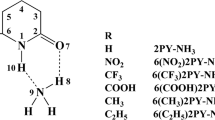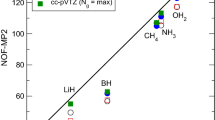Abstract
The variation in reaction dynamics of OH hydrogen abstraction from glycine between HF, MP2, CCSD(T), M05-2X, BHandHLYP, and B3LYP levels was demonstrated. The abstraction mode shows distinct patterns between these five levels and determines the barrier height, and the spin density transfer between OH radical and glycine. These differences are mainly resulted from the spin density distribution and geometry of the alpha carbon during the abstraction. The captodative effect which is commonly believed as one of the major factors to stabilize the caron-centered radical can only be observed in DFT levels but not in HF and MP2 levels. Difference in the abstraction energy were found in these calculation levels, by using the result of CCSD(T) as reference, B3LYP, BHandHLYP, and M05-2X underestimated the reaction barrier about 5.1, 0.1, and 2.4 kcal mol-1, while HF and MP2 overestimated 19.1 kcal mol-1 and 1.6 kcal mol-1, respectively. These differences can be characterized by the vibration mode of imaginary frequency of transition states, which indicates the topology around transition states and determines reaction barrier height. In this model system, BHandHLYP provides the best prediction of the energy barrier among those tested methods.




Similar content being viewed by others
References
Curtiss LA, Raghavachari K, Redfern PC, Pople JA (2000) J Chem Phys 112:7374–7383
Tuma C, Boese AD, Handy NC (1999) Phys Chem Chem Phys 1:3939–3947
Gonzalez L, Mo O, Yanez M (1997) J Comput Chem 18:1124–1135
Johnson BG, Gill PMW, Pople JA (1993) J Chem Phys 98:5612–5626
Toulouse J, Colonna F, Savin A (2004) Phys Rev A 70:62505
Zhao Y, Gonzalez-Garcia N, Truhlar DG (2005) J Phys Chem A 109:2012–2018
Johnson BG, Gonzales CA, Gill PMW, Pople JA (1994) Chem Phys Lett 221:100–108
Song JW, Tokura S, Sato T, Watson MA, Hirao K (2007) J Chem Phys 127:154109
Song JW, Hirosawa T, Tsuneda T, Hirao K (2007) J Chem Phys 126:154105
Goll E, Werner HJ, Stoll H, Leininger T, Gori-Giorgi P, Savin A (2006) Chem Phys 329:276–282
Leininger T, Stoll H, Werner HJ, Savin A (1997) Chem Phys Lett 275:151–160
Truhlar DG, Gordon MS (1990) Science 249:491–498
Truhlar DG, Steckler R, Gordon MS (1987) Chem Rev 87:217–236
Fukui K (1970) J Phys Chem 74:4161–4163
Lu H-F, Li F-Y, Lin S-H (2007) J Comput Chem 28:783–794
Cheng W-C, Soonmin J, Wu C-C, Lin R-J, Lu H-F, Li F-Y (2009) J Comput Chem 30:407–414
Himo F (2000) Chem Phys Lett 328:270–276
Yu D, Rauk A, Armstrong DA (1995) J Am Chem Soc 117:1789–1796
Csaszar AG, Perczel A (1999) Prog Biophys Mol Biol 71:243–309
Galano A, Alvarez-Idaboy JR, Montero LA, Vivier-Bunge A (2001) J Comput Chem 22:1138–1153
Zhao Y, Schultz Nathan E, Truhlar DG (2006) J Chem Theor Comput 2:364–382
Vincenzo B, Maurizio C (1997) J Chem Phys 107:3210–3221
Frisch MJ, Trucks GW, Schlegel HB, Scuseria GE, Robb MA, Cheeseman JR, Montgomery JA Jr, Vreven T, Kudin KN, Burant JC, Millam JM, Iyengar SS, Tomasi J, Barone V, Mennucci B, Cossi M, Scalmani G, Rega N, Petersson GA, Nakatsuji H, Hada M, Ehara M, Toyota K, Fukuda R, Hasegawa J, Ishida M, Nakajima T, Honda Y, Kitao O, Nakai H, Klene M, Li X, Knox JE, Hratchian HP, Cross JB, Bakken V, Adamo C, Jaramillo J, Gomperts R, Stratmann RE, Yazyev O, Austin AJ, Cammi R, Pomelli C, Ochterski JW, Ayala PY, Morokuma K, Voth GA, Salvador P, Dannenberg JJ, Zakrzewski VG, Dapprich S, Daniels AD, Strain MC, Farkas O, Malick DK, Rabuck AD, Raghavachari K, Foresman JB, Ortiz JV, Cui Q, Baboul AG, Clifford S, Cioslowski J, Stefanov BB, Liu G, Liashenko A, Piskorz P, Komaromi I, Martin RL, Fox DJ, Keith T, Al-Laham MA, Peng CY, Nanayakkara A, Challacombe M, Gill PMW, Johnson B, Chen W, Wong MW, Gonzalez C, Pople JA (2004) Gaussian. Gaussian Inc, Wallingford
Jonsson M, Wayner DDM, Armstrong DA, Yu D, Rauk A (1998) J Chem Soc. Perkin Trans 2(1998):1967–1972
Acknowledgments
The authors thank the National Science Council for their financial support. National Center for High-Performance Computing is acknowledged for providing computational resources.
Author information
Authors and Affiliations
Corresponding author
Rights and permissions
About this article
Cite this article
Lin, RJ., Wu, CC., Jang, S. et al. Variation of reaction dynamics for OH hydrogen abstraction from glycine between ab initio levels of theory. J Mol Model 16, 175–182 (2010). https://doi.org/10.1007/s00894-009-0532-z
Received:
Accepted:
Published:
Issue Date:
DOI: https://doi.org/10.1007/s00894-009-0532-z




